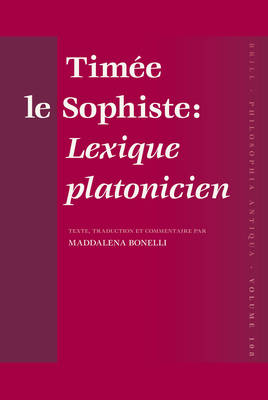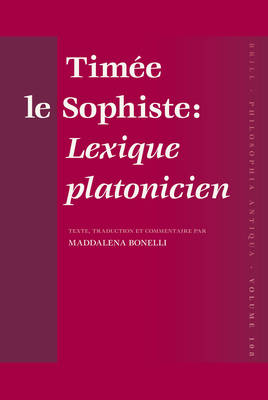
- Afhalen na 1 uur in een winkel met voorraad
- Gratis thuislevering in België vanaf € 30
- Ruim aanbod met 7 miljoen producten
- Afhalen na 1 uur in een winkel met voorraad
- Gratis thuislevering in België vanaf € 30
- Ruim aanbod met 7 miljoen producten
Zoeken
Omschrijving
Ce volume s'occupe du Lexique platonicien de Timée le Sophiste, auteur qui a appartenu à la deuxième sophistique. Une introduction de Jonathan Barnes présente l'histoire des manuscrits de ce lexique et de ses éditions, ainsi qu'une analyse de sa structure et une évaluation de son importance pour la lexicographie ancienne et pour les études platoniciennes. La première partie du livre présente une nouvelle édition du texte avec une traduction française et quatre apparats, des scolies du manuscrit, des loci platonici, des loci similes, et l'apparat critique. La deuxième partie du livre présente un commentaire fourni, qui considère la relation du lexique avec les lexiques atticistes et byzantins, les scolies et les commentaires platoniciens, ainsi que les textes philosophiques.
This book is an edition of the Lexicon to Plato written by Timaeus the Sophist. An Introduction by Jonathan Barnes discusses the history of the manuscripts and editions of the Lexicon, analyses the structure and nature of the work, sites it in the history of ancient lexicography, and attempts to assess its virtues and its importance. The first part of the book contains a new edition of the Greek text, faced by a French translation and equipped with four apparatuses. The second part of the book is the commentary: it is primarily concerned to connect the entries of the Lexicon to appropriate passages in Plato, to trace the links between Timaeus and the ancient tradition of Platonic scholarship, and to locate the Lexicon in thevoluminous and complex history of ancient lexicography.
This book is an edition of the Lexicon to Plato written by Timaeus the Sophist. An Introduction by Jonathan Barnes discusses the history of the manuscripts and editions of the Lexicon, analyses the structure and nature of the work, sites it in the history of ancient lexicography, and attempts to assess its virtues and its importance. The first part of the book contains a new edition of the Greek text, faced by a French translation and equipped with four apparatuses. The second part of the book is the commentary: it is primarily concerned to connect the entries of the Lexicon to appropriate passages in Plato, to trace the links between Timaeus and the ancient tradition of Platonic scholarship, and to locate the Lexicon in thevoluminous and complex history of ancient lexicography.
Specificaties
Betrokkenen
- Auteur(s):
- Uitgeverij:
Inhoud
- Aantal bladzijden:
- 678
- Taal:
- Engels
- Reeks:
- Reeksnummer:
- nr. 108
Eigenschappen
- Productcode (EAN):
- 9789004158870
- Verschijningsdatum:
- 20/07/2007
- Uitvoering:
- Hardcover
- Formaat:
- Genaaid
- Afmetingen:
- 160 mm x 240 mm
- Gewicht:
- 1330 g

Alleen bij Standaard Boekhandel
+ 747 punten op je klantenkaart van Standaard Boekhandel
Beoordelingen
We publiceren alleen reviews die voldoen aan de voorwaarden voor reviews. Bekijk onze voorwaarden voor reviews.











